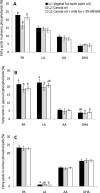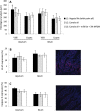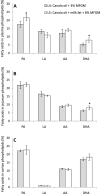Milk fat globule membrane plus milk fat increase docosahexaenoic acid availability in infant formulas
- PMID: 36280613
- PMCID: PMC9941230
- DOI: 10.1007/s00394-022-03024-5
Milk fat globule membrane plus milk fat increase docosahexaenoic acid availability in infant formulas
Abstract
Purpose: Milk fat globule membrane (MFGM) has components with emulsifier properties that could affect the provision of substrates to the brain. We evaluated the effects of MFGM plus milk fat addition to infant formulas on docosahexaenoic acid (DHA) availability and gut development.
Methods: In Experiment 1, suckling piglets were divided into 3 groups: Group L1 (n = 8): fed with a vegetal fat formula with palm oil; L2 (n = 8): canola oil formula and L3 (n = 8): milk fat + canola oil + 1% Lacprodan (3% MFGM of total protein content). In Experiment 2, Group L4 (n = 7): fed with canola oil + 1% Lacprodan (3% MFGM) and Group L5 (n = 5): milk fat + canola oil + 2% Lacprodan (6% MFGM). All formulas contained 0.2% DHA and 0.2% arachidonic acid.
Results: In Experiment 1, DHA was similar among the groups in both total fatty acids and plasma phospholipids (PL). However, 3% MFGM (L3) increased significantly the proportion of DHA and LC-PUFA n-3 in liver total fatty acids, jejunum, and also in jejunum PL respect to the other formulas. There were no changes in gut histology, cell proliferation, apoptosis, or brain DHA content. In Experiment 2, higher MFGM dose was used. Then, higher DHA was not only found in peripheral tissues of 6% MFGM (L5) piglets but also in plasma PL, while a similar trend was observed in cortex PL (p = 0.123).
Conclusion: In conclusion, MFGM plus milk fat may increase DHA availability of infant formulas which could contribute to their beneficial health effects.
Keywords: DHA; Gut; Infant formula; Milk fat globule membrane; Villous.
© 2022. The Author(s).
Conflict of interest statement
The authors declare no conflicts of interest. The funders had no role in the collection, analyses, or data interpretation.
Figures



References
-
- Lopez C, Blot M, Briard-Bion V, Cirie C, Graulet B. Butter serums and buttermilks as sources of bioactive lipids from the milk fat globule membrane: differences in their lipid composition and potentialities of cow diet to increase n-3 PUFA. Food Res Int. 2017;100(Pt 1):864–872. doi: 10.1016/j.foodres.2017.08.016. - DOI - PubMed
-
- Bhinder G, Allaire JM, Garcia C, Lau JT, Chan JM, Ryz NR, Bosman ES, Graef FA, Crowley SM, Celiberto LS, Berkmann JC, Dyer RA, Jacobson K, Surette MG, Innis SM, Vallance BA. Milk fat globule membrane supplementation in formula modulates the neonatal gut microbiome and normalizes intestinal development. Sci Rep. 2017;7:45274. doi: 10.1038/srep45274. - DOI - PMC - PubMed
-
- Wu Y, Zhang X, Han D, Pi Y, Tao S, Zhang S, Wang S, Zhao J, Chen L, Wang J. Early life administration of milk fat globule membrane promoted SCFA-producing bacteria colonization, intestinal barriers and growth performance of neonatal piglets. Anim Nutr. 2021;7(2):346–355. doi: 10.1016/j.aninu.2020.07.012. - DOI - PMC - PubMed
MeSH terms
Substances
Grants and funding
LinkOut - more resources
Full Text Sources
Other Literature Sources
Medical

